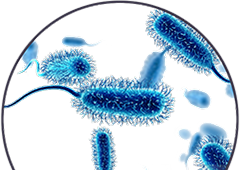
The principle of operation of germicidal lamps is based on UV radiation, which is harmful to microorganisms.
The basis of the bactericidal action is the destruction of the cells of a living organism by ultraviolet rays in the wavelength range of 200-300 nm. This phenomenon is used to disinfect liquids, air and gases from various microorganisms, yeasts and molds and viruses. Germicidal lamps are designed in such a way that approximately 90% of the energy of all ultraviolet radiation of a gas discharge is generated at a wavelength of 253.7 nm. This radiation peak is very close to the peak of the maximum bactericidal efficiency of 265 nm radiation, which has a particularly detrimental effect on microorganisms. UV radiation destroys the DNA of 99.9% of microorganisms, killing many dangerous viruses, bacteria (various staphylococci, enterococci, bacilli), fungi (yeast, mold), mold both in the air and on the surface of tables and other objects in the room. The bactericidal effect of short-wave UV radiation is most effectively used to disinfect drinking water, food production water, swimming pool water and wastewater.
SUBMERSIBLE

ALGAE
• All ballasts have pre-hardened UV lamp electrodes, which significantly prolongs its service life.

VIRUSES
• UV radiation destroys more than 99.9% of the DNA of microorganisms.
• Protects the pool from germs.
• Reduces chlorine and other chemicals by up to 80%.

ESCHERICHIA COLI
• UV-C ultraviolet radiation destroys bound chlorine.
• Destruction of bacteria, spores, fungi and intestinal infections.
Name
Capacity
Line
Obverview






